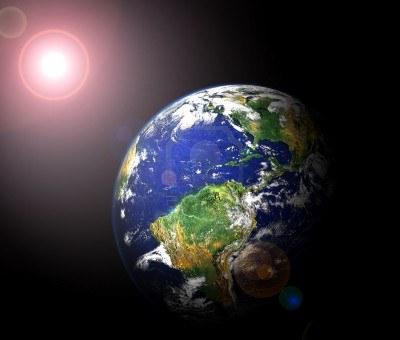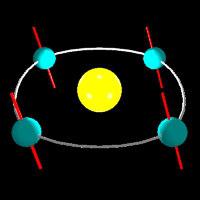Even in ancient times, observing the starry sky, people noticed that in the afternoon the sun, and in the night sky - almost all the stars - from time to time repeat their path. This suggested that there are two reasons for this phenomenon. Either the Earth rotates around the Sun against the background of a motionless starry sky, or the sky rotates around the Earth. Claudius Ptolemy, an outstanding ancient Greek astronomer, scientist and geographer, as if resolved this issue, convincing everyone that the Sun and sky revolve around a motionless Earth. Despite the fact that the geocentric system could not explain many astronomical phenomena, they accepted this.

The heliocentric system, based on a different version, gained its recognition in a long and dramatic struggle. Died at the stake Giordano Bruno, the elderly Galileo acknowledged the "rightness" of the Inquisition, but "... still it spins!"
Today, the rotation of the earth around the sun is considered quite proven. In particular, the motion of our planet in a circumsolar orbit is proved by aberration of starlight and parallactic displacement with a periodicity of one year. Today it has been established that the direction of rotation of the Earth, more precisely, its barycenter, in orbit coincides with the direction of its rotation around the axis, that is, it occurs from west to east.
There are many facts that indicate that the Earth moves in space in a very complex orbit. The rotation of the Earth around the Sun is accompanied by its movement around the axis, precession, nutational oscillations and rapid flight along with the Sun in a spiral within the Galaxy, which also does not stand still.
The rotation of the Earth around the Sun, like other planets, passes in an elliptical orbit. Therefore, once a year, on January 3, the Earth is as close to the Sun as possible and once, on July 5, it is removed from it at the greatest distance. The difference between perihelion (147 million km) and aphelion (152 million km), compared to the distance from the Sun to the Earth, is very small.

Moving in a circumsolar orbit, our planet makes 30 km per second, and the Earth’s revolution around the Sun is completed within 365 d. 6 hours. This is the so-called sidereal or stellar year. For practical convenience, it is considered 365 days a year. “Extra” 6 hours for 4 years in total give 24 hours, that is, one more day. These (run-in, extra) days and add to February every 4 years. Therefore, in our calendar 3 years include 365 days, and a leap year - the fourth year, contains 366 days.
The axis of the Earth's own rotation is inclined to the orbital plane of 66.5 °. In this regard, during the year, the rays of the sun fall on every point on the earth’s surface under
corners. Thus, at different times of the year, points on different
hemispheres of the Earth receive at the same time an unequal amount of light and heat. Because of this, in temperate latitudes, the seasons are pronounced. At the same time, throughout the year, the sun's rays at the equator fall to the earth at the same angle, therefore, the seasons there are slightly different from each other.
On the
day of the summer solstice, the axis of the Earth faces its northern end to the Sun, and its rays plummet at a latitude of 23.5 °. Therefore, starting from the equator to 66.5 °, the day becomes longer than the night. North of latitude 66.5 ° stands a
polar day.